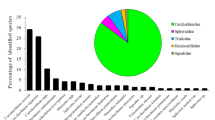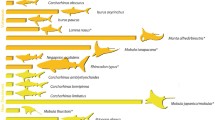Abstract
In the present work, a method for the authentication of more of 100 scorpaenids species has been developed by means of forensically informative nucleotide sequencing technique, which is based on a PCR followed by a phylogenetic analysis. Due to the different commercial value of the species belonging to this taxonomic group, substitutions between species in seafood products can take place. Two different methodological strategies are proposed, allowing the analysis of fresh, frozen, or highly processed products with total reliability. These analytical systems have been validated and subsequently applied to 25 commercial samples. Therefore, this technique can be used as a routine method to avoid the mislabeling in the marketing of scorpaenid species and it is also suitable to assess the correct seafood traceability of these products.


Similar content being viewed by others
References
Amidei RE (1986) Rockfish, a focus for research?: proceedings of a California Sea Grant Workshop. California Sea Grant College Program, Institute of Marine Resources, University of California
Love MS, Yoklavich M, Thorsteinson LK (2002) The rockfishes of the northeast Pacific. University of California Press, Berkeley
Fishbase. http://www.fishbase.org/search.php
Kim IC, Lee JS (2004) The complete mitochondrial genome of the rockfish Sebastes schlegeli (Scorpaeniformes, Scorpaenidae). Mol Cells 17:322–328
IUCN Red List. The IUCN red list of threatened species: http://www.iucnredlist.org
Alesandrini S, Bernardi G (1999) Ancient species flocks and recent speciation events: what can rockfish teach us about cichlids (and vice versa)? J Mol Evol 49:814–818
Johns GC, Avise JC (1998) Tests for ancient species flocks based on molecular phylogenetic appraisals of Sebastes rockfishes and other marine fishes. Evolution 52:1135–1146
Kai Y, Nakayama K, Nakabo T (2003) Molecular phylogenetic perspective on speciation in the genus Sebastes (Scorpaenidae) from the Northwest Pacific and the position of Sebastes within the subfamily Sebastinae. Ichthyol Res 50:239–244
Kendall AW (2000) An historical review of Sebastes taxonomy and systematics. Mar Fish Rev 62:1–23
Rocha-Olivares A, Kimbrell CA, Eitner BJ, Vetter RD (1999) Evolution of a mitochondrial cytochrome b gene sequence in the species-rich genus Sebastes (Teleostei, Scorpaenidae) and its utility in testing the monophyly of the subgenus Sebastomus. Mol Phylogenet Evol 11:426–440
Magnuson-Ford K, Ingram T, Redding DW, Mooers AO (2009) Rockfish (Sebastes) that are evolutionarily isolated are also large, morphologically distinctive and vulnerable to overfishing. Biol Conserv 142:1787–1796
Seeb LW (1998) Gene flow and introgression within and among three species of rockfishes, Sebastes auriculatus, S-caurinus, and S-maliger. J Hered 89:393–403
Rocha-Olivares A (1998) Multiplex haplotype-specific PCR: a new approach for species identification of the early life stages of rockfishes of the species-rich genus Sebastes Cuvier. J Exp Mar Biol Ecol 231:279–290
Rocha-Olivares A (1998b) Molecular evolution, systematics, zoogeography and levels of intraspecific genetic differentiation in the species of the antitropical subgenus Sebastomus, Sebastes (Scorpaeniformes, Teleostei) using mitochondrial DNA sequence data. University of California, San Diego
Rocha-Olivares A, Rosenblatt RH, Vetter RD (1999) Cryptic species of rockfishes (Sebastes:Scorpaenidae) in the Southern Hemisphere inferred from mitochondrial lineages. J Hered 90:404–411
Rocha-Olivares A, Rosenblatt RH, Vetter RD (1999) Molecular evolution, systematics, and zoogeography of the rockfish subgenus Sebastomus (Sebastes, Scorpaenidae) based on mitochondrial cytochrome b and control region sequences. Mol Phylogenet Evol 11:441–458
Rocha-Olivares A, Vetter RD (1999) Effects of oceanographic circulation on the gene flow, genetic structure, and phylogeography of the rosethorn rockfish (Sebastes helvomaculatus). Can J Fish Aquat Sci 56:803–813
Bentzen P, Wright JM, Bryden LT, Sargent M, Zwaneburg KCT (1998) Tandem repeat polymorphism and heteroplasmy in the mitochondrial control region of redfishes (Sebastes:Scorpaenidae). J Hered 89:1–7
Roques S, Duchesne P, Bernatchez L (1999) Potential of microsatellites for individual assignment: the North Atlantic redfish (genus Sebastes) species complex as a case study. Mol Ecol 8:1703–1717
Herrero B, Vieites JM, Espiñeira M (2011) Duplex real-time PCR for authentication of anglerfish species. Eur Food Res Technol 233:817–823
Winfrey MR, Rott MA, Wortman AT (1997) UnraVeling DNA: molecular biology for the laboratory. Prentice Hall, New York
Burgner M, Hübner P (1998) Mitochondrial DNA enrichment for species identification and evolutionary analysis. Eur Food Res Technol 207:261–263
Mc Carthy C (1996) Chromas version 1.45. School of Health science, Griffifth University, Gold Coast Campus, Queensland, Australia
Thompson JD, Gibson TJ, Plewniak F, Jeanmougin F, Higgins DG (1997) The CLUSTAL_X windows interface: flexible strategies for multiple sequence alignment aided by quality analysis tools. Nucleic Acids Res 25:4876–4882
Hall TA (1999) BioEdit: a user-friendly biological sequence alignment editor and analysis program for Windows 95/98/NT. Nucl Acids Symp Ser 41:95–98
Tamura K, Dudley J, Nei M, Kumar S (2007) MEGA4: molecular evolutionary genetics analysis (MEGA) software version 4.0. Mol Biol Evol 24:1596–1599
Saitou N, Nei M (1987) The neighbor-joining method—a new method for reconstructing phylogenetic trees. Mol Biol Evol 4:406–425
Espiñeira M, Gonzalez-Lavin N, Vieites JM, Santaclara FJ (2009) Development of a method for the identification of scombroid and common substitute species in seafood products by FINS. Food Chem 117:698–704
Espiñeira M, Vieites JM, Santaclara FJ (2009) Development of a genetic method for the identification of salmon, trout, and bream in seafood products by means of PCR–RFLP and FINS methodologies. Eur Food Res Technol 229:785–793
Espiñeira M, Vieites JM, Santaclara FJ (2010) Species authentication of octopus, cuttlefish, bobtail and bottle squids (families Octopodidae, Sepiidae and Sepiolidae) by FINS methodology in seafoods. Food Chem 121:527–532
Lago FC, Herrero B, Vieites JM, Espiñeira M (2011) FINS methodology to identification of sardines and related species in canned products and detection of mixture by means of SNP analysis systems. Eur Food Res Technol 232:1077–1086
Lago FC, Vieites JM, Espiñeira M (2012) Authentication of the most important species of freshwater Eels by means of FINS. Eur Food Res Technol 234(4):689–694
Santaclara FJ, Espineira M, Vieites JM (2007) Genetic identification of squids (Families Ommastrephidae and Loliginidae) by PCR-RFLP and FINS methodologies. J Agric Food Chem 55:9913–9920
Bartlett SE, Davidson WS (1992) Fins (forensically informative nucleotide sequencing)—a procedure for identifying the animal origin of biological specimens. Biotechniques 12:408–411
Tamura K, Nei M (1993) Estimation of the number of nucleotide substitutions in the control region of mitochondrial-DNA in humans and chimpanzees. Mol Biol Evol 10:512–526
Hillis DM, Bull JJ (1993) An empirical-test of bootstrapping as a method for assessing confidence in phylogenetic analysis. Syst Biol 42:182–192
Acknowledgments
We thank Fátima C. Lago and Antonio Gavalás for their helpful assistance. We also thank to Vera Sequeira (University of Lisbon, Portugal), Jose Antonio González Pérez (Canary Institute of Marine Science, Spain), José Manuel Bautista (Complutense University of Madrid, Spain), Paloma Morán (University of Vigo, Spain), Sarah Lyon (University of Alaska Fairbanks, Alaska), Malcolm Wyeth (Pacific Biological Station, Nanaimo), Mark Tagal (National Oceanic and Atmospheric Administration, NOAA), Kaj Sünksen (Greenland Institute of Natural Resources, Greenland), Jan Yde Poulsen (University of Bergen, Norway), and Chan Il Park (Gyeongsang National University, Korea).
Author information
Authors and Affiliations
Corresponding author
Rights and permissions
About this article
Cite this article
Espiñeira, M., Vieites, J.M. Authentication of the most important species of rockfish by means of fins. Eur Food Res Technol 235, 929–937 (2012). https://doi.org/10.1007/s00217-012-1824-6
Received:
Revised:
Accepted:
Published:
Issue Date:
DOI: https://doi.org/10.1007/s00217-012-1824-6




